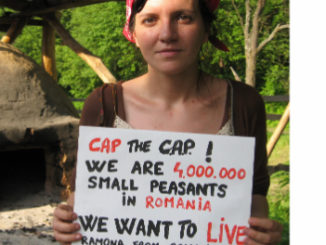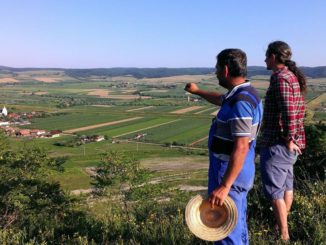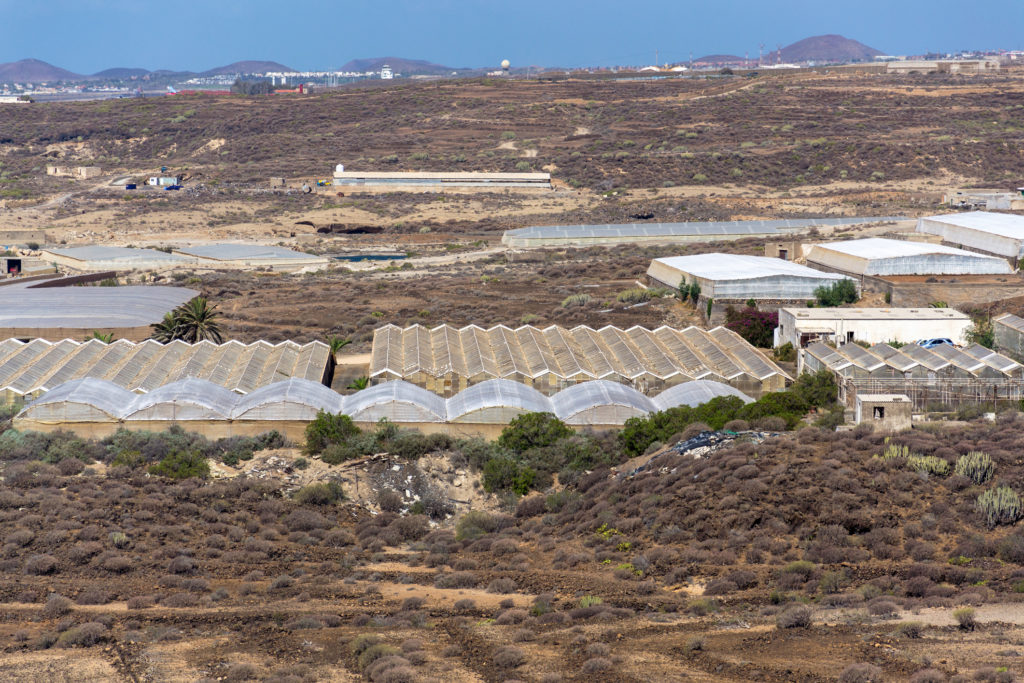
What are the pressures on the agri-food system, what role does CAP and wider EU agri-food policy play, and how could things be different? Here, organisations from Spain, including those in the Coalition Por Otra PAC, outline their problems and solutions. Topics covered include many agri-food system imbalances including fossil fuels, nutrition, ultra-processing/malnutrition, water, soil, waste, the lack of food sovereignty and prioritising EU animal feed over human hunger in the war in Ukraine context. The need for rebalancing and the potential of agroecology are proposed as useful approaches for a more sustainable agriculture.
Article written by: Alberto Díaz of the National Association for the Defense of Animals; Alberto Navarro Spanish Council on Land Stewardship; María Turiño of the Entretantos Foundation; Vanessa Sanchez of the Global Nature Foundation; Ricardo Aliod of the New Water Culture Foundation (FNCA); María Pía Sánchez of “Ganaderas en Red”; Paola Hernández of Mensa Civica; and Aina Calafat of the Spanish Society for Organic Farming and Agroecology (SEAE). Members and friends of the Coalition Por Otra PAC.
Introduction
Due to the large social and environmental impacts of industrial agriculture and livestock farming, the new Common Agricultural Policy (CAP) (2023-27) has introduced some timid reforms to tackle them, in line with the European Green Deal and its Farm to Fork Strategy. For example, it obliges governments to halve the use of pesticides in agriculture by 2030, or encourages natural soil fertility through fallow land and crop rotation.
However, we are witnessing with stupefaction, in the face of the Regulation on the sustainable use of pesticides (the first binding regulation to emerge from the Green Deal), Minister Luis Planas’ questioning of the obligation to reduce the use of 50% of pesticides, and the European Commission’s own Directorate-General for Agriculture and Rural Development acknowledgement that a debate has been opened on postponing the deadlines for its application.
The new CAP regulation also delays the entry into operation of the obligation to rotate crops and maintain fallow land until at least 2024. All of this is accompanied by rejoiced statements from the agricultural lobby, and from the European Commission’s own Commissioner for Agriculture, Janusz Wojciechowski, under the pretext of compensating for the effects of the decrease in cereal supplies and the increase in fertilizer and energy costs, mainly due to the war in Ukraine. Certainly, the war in Ukraine has been the trigger that has clearly brought to the surface a whole series of dysfunctions, which have been dragging on for decades. However, it is not the cause of these dysfunctions.
Consequently, the new CAP, instead of looking to the future, stimulating a change towards more economically resilient, healthy and fair agricultural structures that respond to the social and environmental challenges generated by the current unsustainable model, is committed to the continuity of the dominant industrial and intensive system. However, this is disguised with supposed improvements and accompanied by rhetoric that justifies the maintenance of modes of production that have already proved to be unfeasible in the medium and long term.
Emerging dysfunctions
We are currently witnessing obvious manifestations of profound dysfunctions in the climate, energy supply and the food system, which have long been denounced and anticipated by science and social movements. It is also no coincidence that they appear simultaneously, as they are closely related. Let us look at some of them.
Dependence on declining non-renewable resources
Europe, and the so-called developed world, is run by highly technological countries, with models aimed at maximising production at the lowest possible economic cost, but with a dangerous Achilles’ heel: its structural inefficiency, given that it consumes an enormous amount of non-renewable and declining resources (soil, raw materials, energy, etc.), which in many cases are not possessed, and which generate waste of such a nature and magnitude that the planet cannot assimilate them.
Huge quantities of resources (fertilisers, pesticides, plastics, fuels, electricity) are massively employed in industrial agricultural production, which is only possible under conditions of artificially low energy prices, and with the support of subsidies that distort the perception of the real costs of this type of food production. The latter have become perverse and force an increasing spiral of dependency upon producers, without even preventing the final price of food from rising. If our farmers cannot bare their production costs, imagine what happens in low income countries?
Nutritional inefficiency
Alleged food shortages are used as one of the main excuses for the permanent intensification and expansion of crop cultivation, but the food that is grown is not used efficiently in the European food model. While extensive livestock farming makes use of pastures and stubble that are not in competition with human food, oversized industrial livestock farming consumes enormous quantities of feed made from valuable crops and land that could be used directly for human food, with better yields. This can be seen from the fact that 68% of cereal production in the European Union is destined for animal feed, 78% in the case of Spain, mainly for industrial pigs and chickens (around half of Spain’s meat production is destined for export).
According to data from Woods et al. (2010), the energy footprint of protein intake from beef or pork is 10 times higher than from legumes/pulses, and the footprint of calorie intake is up to 20 times higher than from cereals. The footprint in water usage for the same protein intake is 6 times higher for meat compared to legumes, and up to 20 times higher for calorie intake, as shown in the Table below. If the water footprint comes from blue water (irrigation), the difference in the impact of detractions aggravates the conditions.
Source (Woods et al., 2010) y (waterfootprint.org) |
Water and soil depletion and degradation
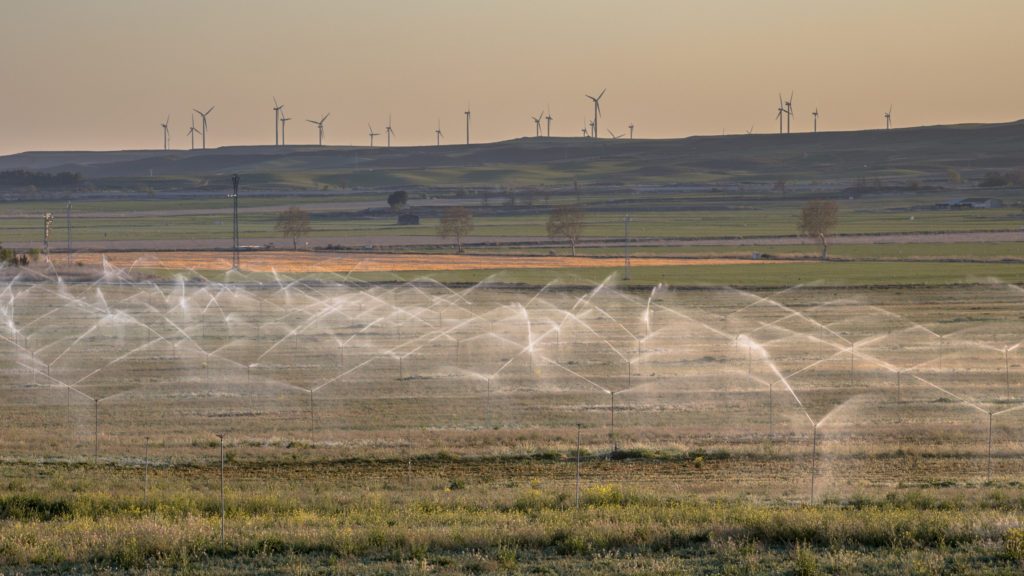
There are also serious impacts on water availability and quality, and on soil fertility and condition. Water availability is being depleted by anthropogenic climate change that increases the frequency and intensity of droughts, especially in the Mediterranean region, and by irrigation in arid and water-scarce areas.
As in the case of industrial meat production, where most of the production is destined for export, irrigated agricultural production is clearly in surplus. Over-intensive agriculture, both irrigated and rainfed, as well as industrial livestock farming generate significant negative impacts on water and soil quality due to excess agrochemicals, fertilisers and waste, with serious repercussions on the environment (water footprint) and health.
Food waste
WWF’s “Driven to Waste” report estimates that 1.2 billion tonnes of food is lost on farms, during and after harvest, as well as in transport and storage. This is equivalent to 15.3% of the total food produced globally. The same report also estimates that total food loss and waste, when including other stages such as processing and consumption, accounts for 40% of all food produced. This is higher than the 33% commonly cited in international reports.
The report also notes that the increases detected in the total amounts of food lost and wasted mean that the amount of greenhouse gas (GHG) emissions generated by food that is not consumed also increases, from 8% in previous estimates to 10%. In addition, this increase in food waste and loss drives land-use change and contributes to environmental degradation unnecessarily.
Lack of food sovereignty
The intrinsic vulnerability of the monoculture and globalisation models of the food chain has become evident, making us dependent on the transport of food and inputs from one end of the planet to the other, flows that can be interrupted or penalised by geopolitical conflicts, pests or increases in transport costs. Conversely, exporters themselves face massive debt, in addition to food price inflation, and the climate crisis, which causes them to fall into a vicious cycle of indebtedness that encourages countries to produce cash crops for export to generate foreign exchange, not food for domestic consumption, and thus face food instability at the local and/or national level.
Ultra-processing and malnutrition
Ultra-processing and over-packaging contribute to making food products unnecessarily expensive and to triggering increases of waste and of climate and ecological footprints. In this regard, a recent article highlights the enormous amount of energy used in the industrial process of food processing and packaging, accounting for 23% of the total energy used in the food system. For example, in Spain, 11% by weight of food is disposable packaging. Moreover, food and beverages generate 80-90% of packaging waste, of which only 26% is recycled. In Western countries, unhealthy diets lead to serious health problems: obesity, and high prevalence of chronic diseases such as diabetes, cardiovascular problems, cancer, including quite notably colorectal cancer among young adults.
The EU’s response as a suicidal flight forward: redoubling the most unsustainable bets
The undisguisable emergence of the most obvious negative impacts – climate change, energy shortages, environmental pollution, loss of biodiversity, etc. – have forced institutions and governments in recent years, not without stubborn resistance, to put recognition of the problem on their political agendas and to formulate reforms, generally timid and far short of the necessary measures.
For example, within the design of the new CAP for the period 2023-2027, some measures were incorporated to improve the sustainability of agricultural production, which make it possible to introduce corrections to reduce dependence on fertilisers, lower diffuse pollution, recover the natural fertility of the soil, and promote biodiversity.
Several of these timid environmental measures, such as crop land rotation and diversification or the promotion of fallow land, have been suspended for 2023, without public debate, under the excuse of the need to increase production due to the war in Ukraine. Environmental measures are now presented as a problem, to be deactivated, rather than as an alternative solution to the impacts and contradictions that the dominant agro-industrial models are leading us towards, as is evident in the current crisis.
And the worst thing is that the proposed exemptions do not bring any improvement to the situation either.
With regard to the exemption of rotation in arable land. Firstly, it must be stressed that rotation is essential for the maintenance of soil fertility in the long term, as recognised by the MAPA itself (Spanish Ministry of Agriculture), the EU, the FAO, the IPCC and other scientific institutions. Soil conservation is essential for the long-term sustainability of agro-ecosystems, as it is a non-renewable resource with a high carbon storage potential.
Moreover, scientific literature and EU agricultural statistics show that crop rotation in rainfed cereals in Spain increases yields. Thus, the non-application of rotations is counterproductive and increases the national shortage of cereals, fodder, and protein crops. There are no forecasts of the effect on production and the market in terms of the expected production impact, broken down by type of crop (protein, cereals, fodder, etc.), nor is there any justification as to which crops should be the subject of priority interventions. There is therefore a risk of imbalance in the supply of raw materials as reflected in the situation of agricultural commodity prices.
With regard to the exemption that will allow fallow land to be sown, the elimination of areas dedicated to non-productive elements has negative environmental, agronomic and socio-economic consequences. The livestock sector, which is clearly in decline due to the current economic situation, will suffer a further setback with this measure, given that many of the fallow lands are grazed on a daily basis, which is expected to increase the demand for fodder and, consequently, the price of fodder. The “non-productive” fallow elements provide positive agronomic effects in terms of pest control, carbon sequestration, pollination, and microclimate regulation. Thus, the disappearance of these green infrastructures will increase the intensity of input use from fossil sources while reducing the area available for soil carbon sequestration.
Last but not least, these derogations will seriously affect agricultural biodiversity as a whole, which is already in serious decline. This decline can be seen in the indicator for farmland birds, whose populations have declined by 57% between 1980 and 2020 in the EU.
The philosophy of the derogations goes in the opposite direction to the commitments on climate change (Paris Agreement, European and National adaptation plans) without increasing agricultural production and yields.
In addition, the derogations are claimed to be justified as a measure to solve “the present problem of food security in the world“. In the same vein, it is anticipated that Brussels intends to authorise GMOs in order to “increase production in the short term in reaction to the situation of Russian aggression against Ukraine and the consequences of this aggression“, and to this end launched a rigged public consultation in March, where 74% of those invited were biotechnology companies and lobbies interested in deregulating the introduction of genetically modified organisms.
In terms of solidarity, Greenpeace points out that Europe uses no less than 162.5 million tonnes of cereals for animal feed compared to the 26 million tonnes of wheat produced by Ukraine. Even if their production/export had been reduced by half due to the effects of the war, in the most unfavourable case, an 8% reduction in livestock production in the EU would be enough to free up the equivalent area of cereal crops for direct human consumption by those who need them most.
The United Nations’ (UN) reports points out that of the total number of cargoes loaded with grain that have departed from Ukraine in the Black Sea since August to date, only 3% have been destined for countries with severe food crises (Afghanistan, Ethiopia, Somalia, Kenya, Sudan and Yemen), while 48% of the ships have arrived in the EU (25% to Spain and 25% to Italy) and 32% to Turkey. In general, the transport of seeds for animal feed (76%) is more important than that of wheat (16%).
The needs of countries hit by food shortages do not seem to be prioritised. Shortages are largely due to the conditions created by the described dysfunctions of the current unsustainable global food model. These dysfunctions are being aggravated by climate change, for which the most industrialised countries are primarily responsible, and which in turn harm in greater scale the least responsible and most affected by hunger.
All signs point to the fact that the dominant food and energy models are coming face to face with the insurmountable wall of limits to growth, which were already set by the Club of Rome in the 1970s. Now, after several extensions, the execution of such a verdict seems to be inexorably catching up with us, leading to growing geopolitical tensions.
Faced with the imminent exhaustion of the economic model of productivist capitalism, paradoxically, the mediocre decisions of European leaders, who at this crossroads would have the responsibility to govern with wisdom and prudence, instead of stopping to reflect and humbly recognise past mistakes, in order to find alternative ways of escape, are redoubling their suicidal gamble, and are trying to ram through legislation even harder pass the wall that can be seen at the end of the corridor, to see if they are lucky and knock it down. But at this dead end where we find ourselves, it is very dark, and perhaps not only a wall awaits us, but also a deep pit, into which falling means suffering unimaginable consequences.
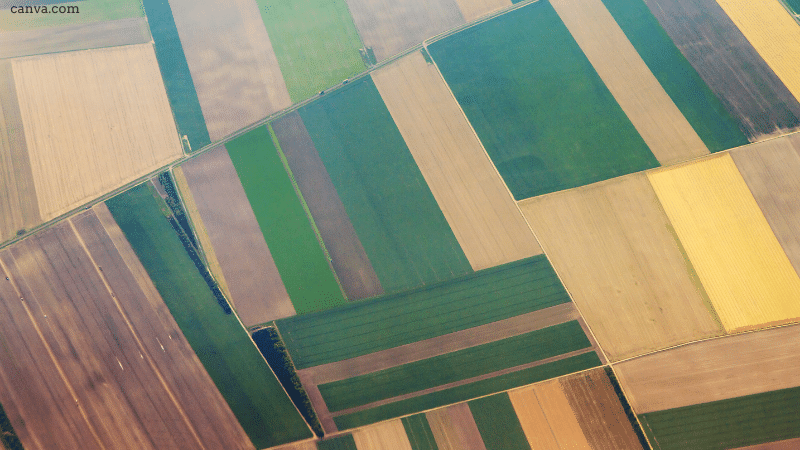
Proposals
There is no easy or simple solution to the complex problems of the world food system, but if we want to overcome the dysfunctions that are manifesting themselves with increasing intensity and frequency, and which could lead to its collapse, we must be aware of the need to accelerate the transition to a different type of model, instead of retreating at any setback.
In the short term, it is feasible to overcome the situation by redirecting at least 10 % of European production of cereals suitable for human consumption, which are currently used for animal feed, to compensate for possible falls in availability and prevent the most disadvantaged populations from being deprived of basic foodstuffs as a result of higher food prices. Given the percentage of world wheat exports from Ukraine (8.9%) and Russia (14%), which together account for a significant 24% of the total, it is necessary to prioritise and facilitate their transport to those areas that depend on them at the current juncture, and to provide them with donations of part of our imports, if necessary.
In addition, many European families who also suffer from poverty should be helped with income or consumption support mechanisms. Support, not based on random charity, to enable them to cope with price increases in basic foodstuffs and many other essential services (e.g. electricity), the low cost of which was taken for granted.
However, in the medium and long term, overcoming the underlying problems requires a decisive and prolonged change of course. Alongside structural changes, we need to consider interventions at the farm level, both to stabilise food supply and to protect the livelihoods of farmers, herders, pastoralists and fisherfolk.
The report ‘An Agroecological Europe in 2050‘ published by the Institute for Sustainable Development and International Relations (IDDRI), demonstrated how agroecology can feed a growing European population with a healthy and sustainable diet. This report was followed by another study that maintains that agroecological farming can also contribute to keeping global warming below 2°C with a 47% reduction in agricultural GHG emissions and the elimination of 380,000 tonnes of pesticides per year from European agriculture, along with benefits for biodiversity, conservation and human health.
Of course, this transition to agroecology is not isolated, as it should be complemented by changes in diet, including a shift towards the consumption of local organic products, to reduce the movement of raw materials and favour the consumption of healthy, fresh and seasonal products, putting an end to ultra-processed foods and increasing the consumption of more plant-based proteins, such as legumes.
Moreover, food production and supply chains must be strengthened in the face of disruptions from extreme events that affect several regions, or the same region sequentially, as was the case during the COVID-19 pandemic and today, and the governance of resilient food systems must be strengthened. The food sovereignty of each country or group of neighbouring countries must be guaranteed without dependence on imports originating thousands of kilometres away.
In this transition towards agroecology, there are measures that must be implemented as soon as possible. We cannot accept the derogations proposed under the excuse of the war in Ukraine, as has been demonstrated, for the simple reason that the desired effect will not be achieved. Even farmers do not understand this change of course. Just as we do not burn books from the national library, just to keep warm, because it is our cultural heritage, we cannot allow our natural heritage to be destroyed.
We hope that the tremendous upheavals we are currently experiencing in the foundations of our production models will ease and peace will come as soon as possible. But the current situation of multiple economic and geopolitical tensions is a serious warning, and a foretaste, of the risks of decomposition, and ultimately collapse, that will assail us periodically and with increasing intensity, if we do not act with determination and urgency.
We need to design and implement global policies that look beyond the crossroads and respond to the climate, biodiversity, energy, food and social emergency that has been triggered. These policies exist and are viable; it is only a question of being ready to take the step and adapt our production systems and life models to the limits that the sustainability of the planet indicates to us.
More
SURe to find excuses – MEPs, Ministers & their PPPs (Persistent Pesticide Proposals)
Ireland | Intensive Farms Must Pull their Weight for a Just Transition
Pesticide Regulation too Important to Delay – Civil Society Orgs
Rural Europe Takes Action | Regenerative Governance in Rural Spain
Letter From The Farm | Learning from a Campesino Family in Cuba


